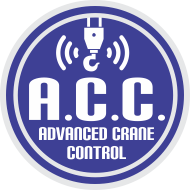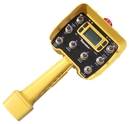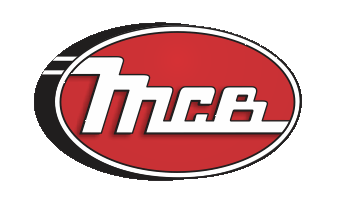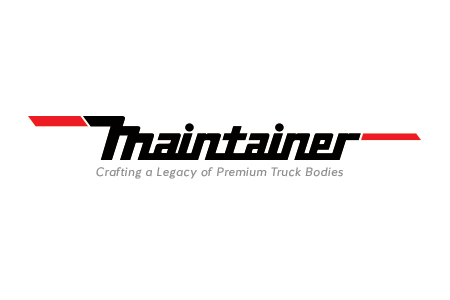Order your FREE Maintainer calendar - Only available while supplies last! >Click HERE to order yours
FAQ
Frequently Asked Questions...
CLICK on a question below to reveal the answer:
Crane & Crane Remote Questions
Frequently Asked Questions
-
NO. There are several types of inspections that are required by OSHA for truck-mounted cranes - initial, post repair, frequent, and periodic (annual). The primary references are OSHA 29 CFR 1926.1412, ANSI B30.5-2, and OSHA 1910.180.
-
» OSHA requires different levels of crane inspection -- frequent and periodic/annual.
[OSHA 1910.180, ANSI B30.5 and OSHA 29CFR Subpart CC (if used in Construction) are the applicable standards.]Frequent inspections (daily to monthly intervals) are are usually performed at the start of each shift by the operator who walks around the crane looking for defects or problem areas.Components that have a direct bearing on the safety of the crane and whose status can change from day to day with use must be inspected daily. When possible, those components should be observed during operation for any defects that could affect safe operation of the crane.
Periodic & Annual inspections (1 to 12 month intervals) are more thorough. - These are intended to determine the need for repair or replacement of components that keep the machine in proper operating condition. It includes those items listed for daily inspections as well as, but not limited to, structural defects, excessive wear, and hydraulic or air leaks. Inspection records of the inspected crane shall be maintained monthly on critical items such as brakes, crane hooks and ropes. It is a complete inspection of the crane and carrier. These inspection records should include the date of inspection, the signature of the person performing the inspection, and the serial number or other identifier. This inspection record should be kept readily available for review. A load test should also be performed at this time.
-
» We do offer our standard Crane Inspection Checklist, which is available at the Product Alerts section (see Technical Bulletins) of MyMaintainer.com. It can also be found on the Service Manual page. We do not specify a formal load test plan. That plan is the responsibility of the crane operator, site manager, or crane inspector.
-
» OSHA requires certified crane operators when operating a crane with more than 2000 pounds of capacity if operating in construction beginning November 10, 2017.
**UPDATE: OSHA issued a Final Rule that operators of most cranes used in construction activity have to be certified by an accredited certification body by December 9, 2018. Employers will have to have completed an evaluation of each operator by February 7, 2019.
For more information, please visit www.NCCCO.org.
-
»NO, the length of the crane does not come into play. If the crane's capacity exceeds 2000 pounds, and the crane is being used in construction, then OSHA requires the operator to be certified beginning December 9, 2018 (under 29 CFR 1926 Subpart CC). For more information, please visit www.NCCCO.org.
-
» At this time Maintainer Corporation of Iowa, Inc. does not offer operator certification. There are several excellent organizations that provide training and testing.
- The National Commission for the Certification of Crane Operators (NCCCO)
2750 Prosperity Ave Ste 505; Fairfax VA 22031; ph 703-560-2391; www.NCCCO.org.
They have a list of qualified training centers at http://www.nccco.org/nccco/training-resources/training-providers/training-companies.The NCCCO is the only organization that we know of that has a specific service truck crane certification program developed, although we have heard that the Crane Institute of America is developing one.
- Crane Institute of America
3880 St. Johns Parkway; Sanford FL 32771; ph 800-831-8588 x122; www.craneinstitute.comMaintainer has been part of NCCCO's service truck crane operator's examination development, and the NTEA's new affiliate group - Telescopic Service Crane Manufacturer's Group (TSCMG).
-
The short answer is yes, utilizing the more protective standard as it isn’t specifically defined is required.
"Construction work." For purposes of this section, "Construction work" means work for construction, alteration, and/or repair, including painting and decorating.
https://www.osha.gov/pls/oshaweb/owadisp.show_document?p_table=interpretations&p_id=21569
(i) The terms "building" and "work" generally include construction activity as distinguished from manufacturing, furnishing of materials, or servicing and maintenance work. The terms include, without limitation, buildings, structures, and improvements of all types, such as bridges, dams, plants, highways, parkways, streets, subways, tunnels, sewers, mains, power lines, pumping stations, heavy generators, railways, * * * excavating,* * *.
In other instances, where an activity cannot be easily classified as construction or maintenance even when measured against all of the above factors, the activity should be classified so as to allow application of the more protective 1910 or 1926 standard, depending on the hazard. In such cases the citation should be issued in the alternative with the emphasis on the more protective standard.
-
The National Commission for the Certification of Crane Operators (NCCCO) maintains a directory of certified crane inspectors in various regions across the country. You can find the directory at their website: http://nccco.org/nccco/locate-a-certified-crane-inspector
-
» Maintainer offers the more traditional short tower cranes that typically mount on top of a service body side pack that is reinforced to handle the ft*lb rating of the designated crane. Maintainer's tall tower cranes sport several advantages as well. By being directly mounted to our reinforced body substructure, the load moment will not affect the integrity of the side pack compartment. Tall towers actually save on overall vehicle weight and provide a lower center of gravity! Learn more at our CRANES page.
-
» Advanced Crane Control (A.C.C.) is a system of sensors and programming that enhances the benefits of the wireless crane remote system. The intent of the system is to create a safer work environment for the operator, as the crane will warn and even take steps to limit unsafe load handling in specific conditions. In 2015 Maintainer's Advanced Crane Control system will be standard on all Maintainer Hydraulic Cranes.

-
»You can contact Maintainer Customer Support to have new decals shipped to you. A diagram showing decal locations and part numbers is available here. Each crane also has specific decals, and Customer Support will be able to assist you.
-
»The service & parts manual that came with you crane calls out the type of grease recommended for that specific crane. To find your manual, as well as a general maintenance schedule guide, please visit our Service Manuals page at MyMaintainer.com.
-
»YES. In addition to the push-button wireless "fully" proportional controller that is standard with all of Maintainer's hydraulic cranes, we also offer two other options.



> Pistol-grip wireless proportional controller, with backup cable
> Tethered, "fully" proportional push-button controllerMore more details, please visit our Crane Remotes page.
-
» The most important part is to turn the crane remote switch to the OFF position when the transmitter is not in use. Although the remote goes into "sleep" mode after 5 minutes, it will continue consuming battery life unless the remote is completely turned off.
-
Telescopic service cranes are rated for picking straight up from the load. While the cranes can rotate fully loaded, there is no rating for swinging the load like a wrecking ball. Neither NCCCO (National Commission For The Certification of Crane Operators) nor NTEA TSCMG (National Truck Equipment Assn's Telescopic Service Crane Manufacturers Group) have designations for swinging load charts for mobile cranes like Maintainer.
-
In order to link your crane remote to your receiver, you need to go through a pairing process. This can be done through a series of simple steps.
For the TD1140 Standard Remote see here: Linking TD1140 Standard Remote
For the TD2100 PGT see here: Linking TD2100 PGT
For the Magnetek see here: Linking Magnetek Remote
-
In order to adjust your backlight brightness and time for your crane remote, there is a series of steps to go through.
For the TD1140 Standard Remote see here: TD1140 Standard Remote
For the TD2100 PGT see here: TD2100 PGT
-
If crane speeds have been messed up sometimes there needs to be some adjustments made. In order to do this, you will have to call the customer service department for the password. After that, a series of steps seen in the videos below will help you do so. The easiest way is to use the compartment display screen if you have it.
For the Compartment display screen see here: Display Screen
For the TD1140 Standard Remote see here: TD1140 Standard Remote
For the TD2100 PGT see here: TD2100 PGT
-
If your miller EnPak seems to be running slow or not at the correct speed the hydraulic flow could be off.
In order to check that see this video. Miller Enpak Hydraulic Adjustment
-
If you are unsure if you are linked up to your TD1140 crane remote correctly, you can check the serial number by following this video.
See here: Serial Number Check on TD1140
-
If you are unsure if your e-stop is working right or any of the other buttons there is a simple button test that you can go through for the TD1140 remote.
See here: Button Test Video
General Maintenance Questions
Frequently Asked Questions
-
» Maintainer offers suggested replacement periods for high pressure, return, PSS, and air filters as well as filler breathers. Download this pdf document for recommendations: >Filter Schedule
-
» Maintainer has manual of describing recommended maintenance procedures at the Service Manuals page at www.MyMaintainer.com. This manual also provides information on crane service and operation. Operation_and_Maintenance__2015.pdf
-
»Due to current regulations on shipping hazardous materials, Maintainer will not ship paint or paint-related products to customers.
-
»Customers should work with their authorized Maintainer Dealer on potential warranty claims.
Documentation on the Warranty Claim Procedure can be found at the Warranty Info page of MyMaintainer.com.
The process will be expedited for units that have completed the Warranty Registration, also found on the Warranty Info page.
-
Maintainer has a door rod adjustment procedure to pull the door in tighter or to loosen up a tight fit. CLICK HERE for the door rod adjustment procedure. Or, contact your local Maintainer Dealer for assistance.
Fuel & Lube Truck / Lube Skid Questions
Frequently Asked Questions
-
» Federal regulations regarding the transportation of hazardous materials can be found in detail at the U.S. DOT PHMSA website. Registration depends on the type of material, the quantity being transported, and the volume of each container. Transporting hazardous materials may require hazard placards on the truck. Refer to OSHA 172.500 for hazard placard requirements.
You may also want to consult the Federal Motor Carrier Safety Administration (www.fmcsa.dot.gov) in regards to documentation that must be carried in the vehicle.
Also note that state DOT and local regulations may be more stringent than federal regulations. It is the responsibility of the operator to be aware of and compliant with these regulations.
-
» Federal OSHA regulation 49 CFR 172.101 classifies diesel as a Hazard Class/Division 3, combustible liquid rather than flammable (Table 172.101). Diesel fuel in containers greater than 119 gallons is subject to 49 CFR 173.242. If 120 gallons or more of Diesel is being carried, hazard placards would be required, as more than 119 gallons is considered a "bulk tank." 173.500 (6) states that combustible liquids in non-bulk packaging (less than 120 gallons) are exempt from placarding requirements.
Be aware that state DOT or local regulations may be more stringent than federal regulations. It is the responsibility of the operator to be aware of and compliant with these regulations.
-
A holder of a CDL who operates a commercial motor vehicle (CMV) that must be placarded for transporting hazardous materials must also obtain the Hazmat (H - Hazardous Materials) endorsement for their CDL.
-
» Combustible liquids are those with a flash point at or above 100° F.
Federal OSHA regulation 49 CFR 172.101 classifies Diesel Fuel as a Hazard Class / Division 3 combustible liquid rather than flammable (Table 172.101) since the flash point is above 100° F.
Gasoline ha s a flash point below 100° F, so it is a flammable liquid.
Oils generally have a flash point above 100° F, so they are combustible rather than flammable. -
» Diesel fuel does not require a certified tank in the United States. (See next question below.) However, a DOT 406 certified tank is required to transport diesel fuel in Canada.
Gasoline requires a DOT 406 certified tank for both the U.S. and Canada. Gasoline tanks in limited configuration less than 120 gallons can be obtained through Maintainer working with a partner with a special DOT exemption.
Oils do not require a certified tank in the U.S. or Canada.NOTE: It is the responsibility of the owner/operator to be aware of and compliant with the regulations for their state, province or locality.
-
Diesel is classified as a Hazard Class/Division 3 PG (packaging group) under 49 CFR 172.101
49 CFR 172.101 (d)(4) states that diesel is classified as a combustible liquid because its flash point is above 100ºF.
49 CFR 173.150(f)(3) states that "a combustible liquid in bulk packaging is not subject to the requirements of this subchapter..."
Because of this exemption under federal law, diesel fuel does not need to be transported in DOT 406 tanks in the United States. State and local laws may be more stringent, and it is up to the owner/operator to be aware of specific regulations in the area.
-
» Federal OSHA regulation 49 CFR 172.500 regards hazard placard requirements. If 120 gallons or more of Diesel is being carried, this would be considered a "bulk tank" and hazard placards would be require. Diesel fuel in containers greater than 119 gallons is subject to 49 CFR 173.242. Federal OSHA regulation 49 CFR 172.500(6) states that combustible liquids in non-bulk packaging (less than 120 gallons) are exempt from placarding requirements.
-
» We are not familiar with all driver certification requirements, but if transporting diesel in a bulk tank, hazardous material driver endorsement will be necessary. You will have to check with your State DOT regarding regulations such as required documentation and safety manuals that must be carried in the vehicle.
Check the DOT's FMCSA website for more information.
Be aware that state, provincial, and local regulations may be more stringent than federal regulations. It is the responsibility of the operator to be aware of and compliant with these regulations.
-
The answer should be NO.
Petroleum oils have a flash point around 370°F. Flammable liquid is defined as including materials whose flash point is not more than 141F. [49CFR 173.120(a)]
The lube skid would NOT need a hazmat endorsement, or a tank endorsement for the driver, if petroleum oils are being transported.
49CFR 172.500 regards placarding.
49CFR 172.504(c) requires placards for any quantity of hazardous material.The total gallons on the skid do not exceed 1000 gallons (which would also require the endorsement).
Having said that, some states or municipalities may have their own regulations that may supersede the federal regulations. Be sure to check with local authorities in this regard.
Options & Accessories Questions
Frequently Asked Questions
-
» Maintainer's patented Pressurized Storage System (PSS) is an option installed on nearly 90% of the service bodies that we manufacture. The system pushes air into the cabinet while traveling to the job site. When combined with our premium cabinet construction, the PSS system keeps dust and moisture away, protecting your tools and other equipment stored inside! Learn more PLUS check out the video ate our PSS page: Pressurized Storage System (PSS)
-
» Maintainer or a Maintainer Dealer can send you the parts to install the Master Locking System on your truck body. If you have an older Maintainer body, the process will be trickier, as you will need to drill the holes through the cabinets. Current models are designed to accommodate the Master Locking System. To save time, though, you should consider contacting your Maintainer dealer for quote on installation.
-
Maintainer does not offer rough finish or textured automotive paint. Maintainer does offer the option of DuraBull protective spray for our truck bodies.
-
Maintainer now offers eight tire jib crane attachments, both with 2' additional reach and 3000-lb lift capacity. Learn more at our TIRE JIB page.
-
The best way to remove a drawer is to remove the 8 bolts that attach the rollers to the drawers. This could help in the case where a tool or part gets caught between two drawers.
Company Information
Frequently Asked Questions
-
» Maintainer has two Production Plants in the Northwest Iowa city of Sheldon. We also have another production facility in the city of Rock Rapids, Iowa. Find Us by going to the Find Our Location page.
-
» Maintainer has been in business since 1976. Learn more at our History page.
Rescue Trucks / Fire Vehicles
Frequently Asked Questions
-
» The MCB brand of Rescue Trucks, Quick Attack Vehicles, Mobile Command and other specialty emergency vehicles has been sold to Ward Apparatus (February 2021). Click on the logo or go to mcbfire.com to learn more about their fire trucks and rescue vehicles.

